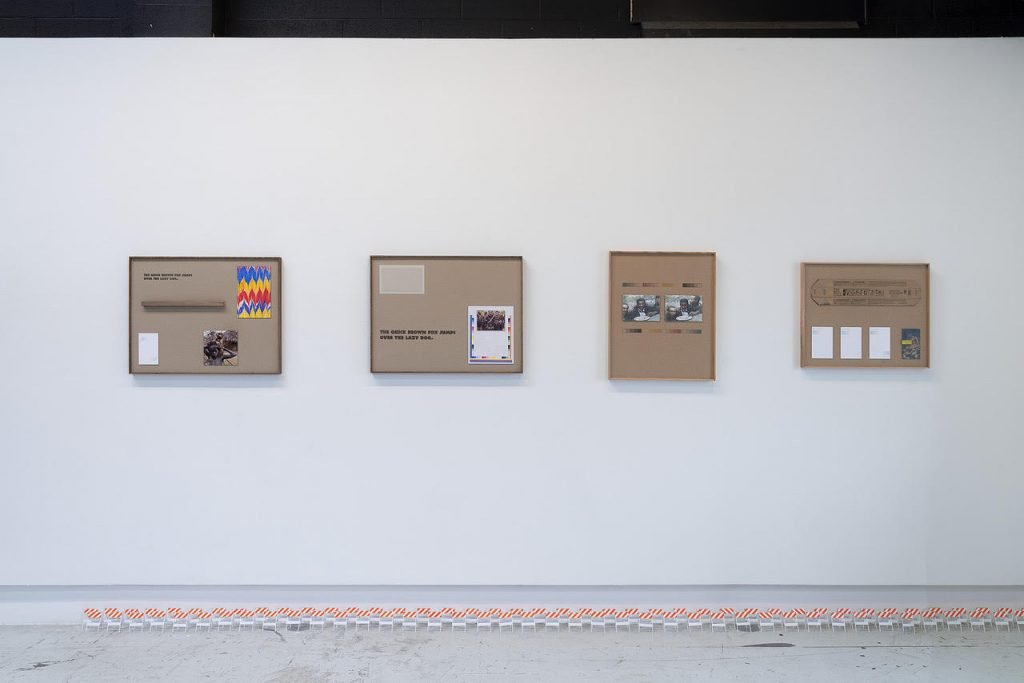Exploring Cultural Memory in The Work of Lyndon Barrois Jr.
Of Color by Lyndon Barrois Jr. @ Contemporary Art Museum of St. Louis. Photo Courtesy of David
Johnson
I first encountered Lyndon Barrois Jr.’s work at the CAMSTL where his installation Of Color
was exhibited. In the gallery was half a basketball court: fresh, black asphalt with crisp white
lines, a hoop, and a basketball. Complicating this construction were structures made of
stacked toner boxes and adorned with fragmented halftone catalog photographs of shoes
and clothing, each topped with a cardboard cutout of a hat or hair. These sculptures were
both figurative, arranged like basketball players on a court, and architectural, like
skyscrapers on a city skyline. As a physical space, the installation allowed viewers to move
through the court and through the box towers. I interpreted this work as an assertion of
legitimacy of the street court as a space for Black expression and culture.
Of Color by Lyndon Barrois Jr. @ Contemporary Art Museum of St. Louis. Photo Courtesy of David Johnson
Barrois’ new work, shown in the exhibition Sensible Disobedience, included a series of four
collages, along with three small sculptural pieces. Unlike Of Color, these works didn’t
command the entire gallery space, but shared walls with other artists’ pieces, thus creating
new contexts. In fact, Oli Watt’s tiny traffic barriers interacted directly with the Barrois’
sculptures. The collages were each on brown chipboard, framed by dark wood: A National
Geographic image of a small shirtless Black boy holding a monkey, paper marbled with blue,
yellow, red, CMYK test prints, the well-known pangram “The Quick Brown Fox Jumps Over
the Lazy Dog”—the elements of each collage feel deliberately chosen and arranged. Much
like the sculptures in Of Color, these new structures were made of toner boxes and spent
toner cartridges. But they were far shorter, and lacked a sense of figurativeness; instead they
seemed more formal, bringing to the forefront their materiality as waste products of the
printing process. Viewed together with Watt’s traffic barriers, I began to think about printing
as means of accessing an audience and having influence, and then who is barred from that
by what may feel like hundreds a tiny barriers.
Installation of Lyndon Barrois Jr.’s work (also featuring Oli Watt’s barricades) in Sensible Disobedience at
La Esquina. Photo by E.G. Schempf
Barrois evokes cultural memory–that is both collectively and selectively remembered. He
allows his viewers to shift their understanding of familiar images, to see them in new
contexts. The magazine pictures of the boy and monkey, the tribal women, and the mother
and child are immediately recognizable as being from National Geographic. In recognizing
the image, I had a number of immediate connotations: I was struck first by a sense of
nostalgia for film photography and childhood adventure, then by the voyeurism and
exoticization of the subjects of the photos, then by a sense of appreciation of the photos as
intimate portraits. Each element in the collage evoked a series of immediate impressions.
They were hieroglyphs that contained layers of meaning for each person who views them.
Combined, the images can take on different meanings than they do individually. But
whatever new meaning they take on, there is still an understanding of each elements on its
own.
This understanding of the image by Barrois, both in popular culture and the art historical
canon, allows him to subvert the visual representations of each to create other meanings and
narratives. Throughout his body of work, he has explored the various methods of
manipulating the image—cropping, collage, curation, and juxtaposition. He draws his source
material from films, history and art history, popular magazines, and photography. By
recontextualizing found sources, he takes control of existing images and their attached
associations and is able to forge messages of his own.
Installation of Lyndon Barrois Jr.’s work (also featuring Oli Watt’s barricades) in Sensible Disobedience at La Esquina. Photo by E.G. Schempf
Our culture relies on the image to represent the abstract concepts and values that form our
identities as individuals and as communities. We use images to define our version of history,
to streamline events and perspectives too vast and inexact to capture. This makes the image
a powerful tool. It designates within a culture, what is beautiful—and therefore what is ugly—,
what is good—and therefore what is bad—, what is desirable—and therefore what is
detestable. The image reinforces accepted aesthetic values until they are considered truth.
Barrois’ work reminds us that images, and our associations to them, are manufactured, not
inherent, and the repeated use of the toner box and repeated reference to the CMYK
process signifies that. It is possible to use the CMYK process to only ever create one color,
but that singularity does not represent its ability to make many hues. In creating totems from
the remnants of the process—the empty ink cartridges and packaging—he illustrates an
ordinary origin of the images that our culture reveres. The printed words on the boxes, turned
outward toward to viewer and that read “waste box”, describe warnings, and show illustrated
instructions, invites us to question the ultimate authority of images, as they are created by
people as fallible as ourselves.





